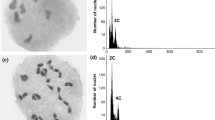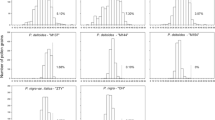Abstract
Based on the size differences found between haploid and diploid pollen produced by diploid and tetraploid rose cultivars, respectively, 2n pollen producers were identified in a population of 53 diploid hybrids from a cross between a dihaploid rose, derived from the haploidization of a tetraploid modern cultivar and the diploid species R. wichuraiana. Frequency of 2n pollen producers was estimated in 2002, 2003 and 2004. Highly variable frequencies were found i) within population; ii) during years of observation (between years and between different months in the same year). The variation of 2n pollen production could be related to environmental fluctuations. A cytological analysis of male meiosis was carried out in 10 hybrids randomly chosen. Among meiotic abnormalities leading to 2n pollen formation, triads (containing a 2n microspore at one pole and two n microspores at the other) resulting from abnormal spindle geometry were frequently observed. The mode of 2n pollen formation is genetically equivalent to a First Division Restitution (FDR) mechanism. FDR 2n pollen transmits a high percentage of the heterozygosity from the diploid parent – 2n pollen producer-to the tetraploid offspring.
Similar content being viewed by others
References
Baker BS, Carpenter ATC, Esposito MS, Esposito RE, Sandler L (1976) The genetic control of meiosis. Ann Rev Genet 10: 53–134
Berninger E (1992) Le rosier de serre pour fleurs à couper. In Gallais A, Bannerot H (eds) Amélioration des espèces végétales cultivées, objectifs et critères de sélection. INRA Editions, Paris. pp 490–504
Bretagnolle F, Thompson JD (1995) Gametes with the somatic chromosome number: mechanisms of their formation and role in the evolution of autopolyploid plants. New Phytol 129:1–22
Crespel L, Gudin S (2003) Evidence for the production of unreduced gametes by tetraploid, Rosa hybrida L. Euphytica 133:65–69
Crespel L, Gudin S, Meynet J, Zhang D (2002) AFLP-based estimation of 2n gametophytic heterozygosity in two parthenogenetically derived dihaploids of Rosa hybrida L. Theor Appl Genet 104:451–456
Crespel L, Meynet J (2003) Manipulation of ploidy level. In Roberts AV, Debener T, Gudin S (eds) Encyclopedia of Rose Science. Elsevier Academic Press, pp 5–11
Darlington CD (1937) Recent advances in cytology. 2nd edn, P. Blakinston's son and Co, London
Darlington CD, Wylie AP (1955) Chromosome atlas of flowering plants. 2nd edn, Allen & Unwin, London
De Vries DP, Dubois LAM (1996) Rose breeding: past, present and future. Acta Hort 424:241–248
Den Nijs APM, Stephenson AG (1988) Potential of unreduced pollen for breeding tetraploid perennial ryegrass. In Cresti M, Gori P, Pacini E (eds) Sexual reproduction in higher plants. Springer-Verlag, Berlin, pp 131–136
El Mokadem H, Crespel L, Meynet J, Gudin S (2002a) The occurrence of 2n-pollen and the origin of sexual polyploids in dihaploid roses (Rosa hybrida L.). Euphytica 125:169–177
El Mokadem H, Meynet J, Crespel L (2002b) The occurrence of 2n eggs in the dihaploids derived from Rosa hybrida L. Euphytica 124:327–332
Gudin S (2000) Rose: genetics and breeding. Plant Breed Rev 17:159–189
Jacob Y, Pierret V (2000) Pollen size and ploidy level in the genus Rosa. Acta Hort 508:289–292
Jacob Y, Teyssier C, Reynders-Aloisi S, Brown SC (1996) Use of flow cytometry for the rapid determination of ploidy level in the genus Rosa, Acta Hort 424:273–278
Kaul MLH, Murphy TGK (1985) Mutant genes affectinf higher plant meiosis. Theor Appl Genet 70:449–466
Maïa N, Venard P (1976) Cytotaxonomie du genre Rosa et origine des rosiers cultivés. In: Fédération Nationale des Producteurs de l'Horticulture et des Pépinières (eds) Travaux sur le rosier de serres menés au C.R.A. d'Antibes. INRA, Antibes (France), pp 7–20
Maizonnier D (1976) Production de tétraploïdes et de trisomiques naturels chez le Pétunia. Annales d'Amélioration des Plantes 26:305–318
Meynet J, Barrade R, Duclos A, Siadous R (1994) Dihaploid plants of roses (Rosa × hybrida) obtained by parthenogenesis induced using irradiated pollen and in vitro culture of immature seeds. Agronomie 2:169–175
McCoy JJ (1982) The inheritance of 2n pollen formation in diploid alfalfa Medicago sativa. Can J Genet Cytol 24:315–323
Mok DWS, Peloquin SJ (1975a) Three mechanisms of 2n pollen formation in diploid potatoes. Can J Genet Cytol 17:217–225
Mok DWS, Peloquin SJ (1975b) The inheritance of three mechanisms of diplandroid (2n pollen) formation in diploid potatoes. Heredity 35:295–302
Myers JR, Gritton ET, Struckmeyer BE (1984) Production of 2n pollen and further characterization of the calyx carpellaris (cc) trait in the pea. Crop Sci 24:1063–1069
Parrot WA, Smith RR (1984) Production of 2n pollen in red clover. Crop Sci 24:469–472
Parrot WA, Smith RR (1986) Recurrent selection for 2n pollen formation in red clover. Crop Sci 26:1132–1135
Quinn AA, Mok DWS, Peloquin SJ (1974) Distribution and significance of diplandroids among the diploid Solanum. Amer Potato J 28:537–561
Ramanna MS (1983) First division restitution gametes through fertile desynaptic mutants of potato. Euphytica 32:337–350
Ramsey J, Schemske DW (1998) Pathways, mechanisms, and rates of polyploid formation in flowering plants. Annu Rev Ecol Syst 29:467–501
Rehder A (1960) Manual of cultivated trees and shrubs in North America. 2nd edn; Springer, Berlin
Rowley GD (1960) Aneuploidy in the genus Rosa. Journal of Genetics 57:258–268
Souza AM, Pagliarini MS, Carraro IM (1999) Abnormal spindles in second meiosis in canola (Brassica napus and Brassica campestris) Braz Arch Biol Tecnol 42:47–52
Veilleux R (1985) Diploid and polyploid gametes in crop plants : Mechanisms of formation and utilization in plant breeding. Plant Breed Rev 3:252–288
Veilleux RE, Lauer FI (1981) Variation for 2n pollen production in clones of Solanum phureja Juz. And Buk. Theor Appl Genet 59:95–100
Werner JE, Peloquin SJ (1991) Occurrence and mechanisms of 2n egg formation in 2x potato. Genome 34:975–982
Author information
Authors and Affiliations
Corresponding author
Rights and permissions
About this article
Cite this article
Crespel, L., Ricci, S.C. & Gudin, S. The production of 2n pollen in rose. Euphytica 151, 155–164 (2006). https://doi.org/10.1007/s10681-006-9136-1
Received:
Accepted:
Published:
Issue Date:
DOI: https://doi.org/10.1007/s10681-006-9136-1




